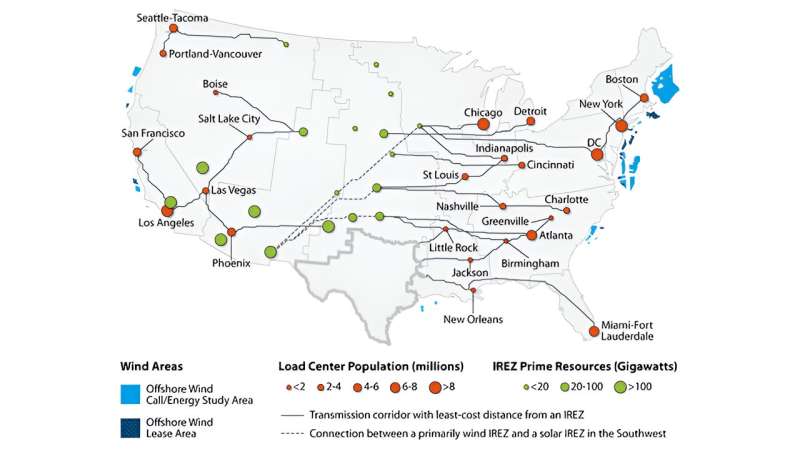This article has been reviewed according to Science X's editorial process and policies. Editors have highlighted the following attributes while ensuring the content's credibility:
fact-checked
trusted source
proofread
Can we connect renewable energy hubs with electricity consumption hubs?

A new approach to grid planning could make it possible to power your home with the nation's best and lowest-cost wind and solar energy, no matter where you live.
Researchers at the National Renewable Energy Laboratory (NREL) led the analysis with the Pacific Northwest National Laboratory (PNNL) studying the economics of building long-distance, high-voltage transmission lines that are anchored to interregional renewable energy zones (IREZs), or areas with very high concentrations of the lowest-cost developable renewable energy potential. The envisioned transmission lines would cross hundreds of miles and link the nation's best renewable energy resources to the biggest load centers.
Based on the NREL analysis, the IREZ approach could save money overall, help keep the lights on, and prudently speed up the pace of decarbonizing the nation's electric grid.
Modeled benefits of interregional renewable energy zones
Today, almost all transmission lines are local or regional, as opposed to interregional, which would cross planning authority seams. Transmission lines were originally designed to bring power from power plants to nearby communities. But most of the nation's best wind and solar resources are located hundreds of miles away from areas with lots of electricity demand.
For this study, NREL modeled 20 IREZ scenarios focusing on cost, reliability, and electricity rate impacts. Nearly all wind IREZ regions are in the Midwest, and all solar IREZs are in the Southwest. IREZs provide the potential to optimize energy generation costs, with costs per kilowatt-hour less than that of wind and solar elsewhere.
Each zone contains an IREZ hub, where transmission substations collect power from various renewable energy plants and connect them to bulk power systems. Power from an IREZ is sent along high-voltage direct current transmission paths across state lines to major load centers (pictured in red above).
Using IREZ transmission planning, low-cost renewable electricity could be sent from areas like southern Wyoming—which has one of the highest wind energy potentials in the country—to cities like Salt Lake City, Las Vegas, and Los Angeles. Many of the modeled IREZ corridors already have high-voltage transmission projects that are either in advanced planning stages or are already under construction.
Additionally, many of the IREZ corridors were modeled in areas identified in the U.S. Department of Energy's (DOE's) Grid Deployment Office's National Transmission Needs Study that need deployment to meet future demand, generation, and reliability needs.
NREL found the potential savings from the low cost of renewable generation offset the cost of building the long-distance interregional transmission corridors. Plus, the IREZ corridors could provide more reliable resources to help keep the lights on than depending solely on local or regional resources.
Mapping out interstate collaboration for IREZ corridors
A crucial component to the potential creation of IREZ corridors is collaboration between states.
"Long-distance transmission between planning regions was always harder to get through the approval process than new lines within the same region," NREL researcher and lead author David Hurlbut said. "But over the past few years the power sector has been changing in ways that might make interregional transmission a more compelling option than it used to be."
The NREL study assumed that the path of least regulatory resistance was collaboration among states leading decisions on development of IREZ corridors.
"States are crucial decision makers in the transmission process," Hurlbut said. "The IREZ analysis is designed to make it easy for states to answer the regulatory questions they need to satisfy in order to get beneficial interregional lines moving."
States along the same corridor could work together to pursue the most cost-effective options for transmission planning and means to compensate landowners where proposed transmission lines could go. The study assumed that once states reach agreements on IREZ corridor development, they could reach out for federal financial, regulatory, and analytical support.
The study also explored the implications for tribal lands, notably those in western Oklahoma, northwestern Montana, and southeastern Arizona. The hope is that the findings from the study could help inform tribal decisions about how they wish to participate in the nation's energy transformation with respect to land access, employment, tribal revenues, and other IREZ corridor development questions.
IREZs are an actionable piece of a larger national picture that NREL and PNNL have been studying for more than two years. The National Transmission Planning Study (NTP Study), conducted by NREL and PNNL, aims to identify transmission options that will provide broad-scale benefits to electric customers, inform regional and interregional transmission planning processes, and identify interregional and national strategies to accelerate decarbonization while maintaining system reliability.
The NTP Study will be complemented by several companion reports, the first of which is the IREZ report. The NTP Study and its key findings will be released later this year, along with a companion report to IREZ that explains the regulatory challenges to interregional transmission that have historically prevented realizing many of the benefits quantified in the NTP Study technical scenarios.
More information: Interregional Renewable Energy Zones: www.nrel.gov/docs/fy24osti/88228.pdf

















